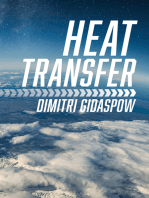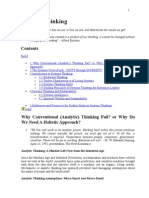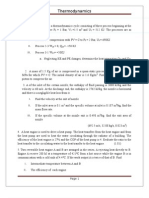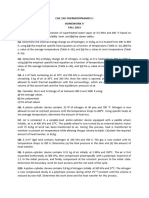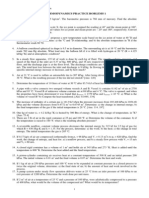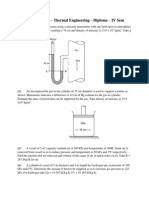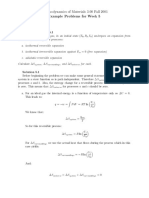Tutorial Problem: Entropy: T T S MC TT
Tutorial Problem: Entropy: T T S MC TT
Uploaded by
Aditya TiwariCopyright:
Available Formats
Tutorial Problem: Entropy: T T S MC TT
Tutorial Problem: Entropy: T T S MC TT
Uploaded by
Aditya TiwariOriginal Title
Copyright
Available Formats
Share this document
Did you find this document useful?
Is this content inappropriate?
Copyright:
Available Formats
Tutorial Problem: Entropy: T T S MC TT
Tutorial Problem: Entropy: T T S MC TT
Uploaded by
Aditya TiwariCopyright:
Available Formats
Tutorial Problem: Entropy
1. A spring loaded piston-cylinder setup contains 1.5kg of air at 270C and 160kPa. It is now heated in a
process where pressure is linear with volume, P=a+bV, to twice the initial volume where it reaches 900K.
Find the work, heat transfer, and total entropy generation assuming a source at 900K. [161.44kJ, 806.74kJ,
0.584kJ/K].
2. Air is compressed steadily by a 5kW compressor from 100kPa and 170C to 600kPa and 1670C at a rate of
1.6kg/min. During this process, some heat transfer takes place between the compressor and the surrounding
medium at 170C. Determine the rate of entropy change of air during this process. What is the amount of
entropy generation? [-0.00254kW/K, 8.39x10-4 kW/K]
3. Two vessels, A and B each of volume 3m3 may be connected by a tube of negligible volume. Vessel A
contains air at 0.7MPa, 950C, while vessel B contains air at 0.35MPa, 2050C. Find the change in entropy
when A is connected to B by working from the first principles and assuming the mixing to be complete and
adiabatic. [0.9477kJ/K]
4. A frictionless piston-cylinder is loaded with a linear spring having a spring constant 100 kN/m and the
piston cross-sectional area is 0.1 m2. The cylinder having an initial volume of 20 L contains air at 200 kPa
and ambient temperature, 300K. There exists a stop in the cylinder which prevents its volume from
exceeding 50 L. A valve connects the cylinder to an air supply line flowing air at 800 kPa, 325K. The valve
is now opened, allowing air to flow in until the cylinder pressure and temperature reaches 800 kPa and
350K respectively. The valve is then closed and the process ends. (a)At the final state does the piston reach
the stop? (b) Calculate the heat transfer during the process. (c) Calculate the entropy generation for this
process. [yes, -14.48kJ, 0.0633kJ/K]
5. Air is flowing steadily in an insulated duct. The pressure and temperature measurements of the air at two
stations A and B are given below. Establish the direction of the flow of air in the duct. Assume that for air,
sp. heat cp is constant at 1.005kJ/kgK, h=cpT and (v/T)=0.287/P, where p, v and T are pressure (in kPa),
volume (in m3/kg) and temperature (in K) respectively. Station A: p=130kPa, T=500C and Station B:
p=100kPa and T=130C. [from B to A]
6. A cylindrical rod of length L insulated on its lateral surface is initially in contact at one end with a wall
at temperature T1 and the other end with a wall at lower temperature T2. The temperature within the rod
initially varies linearly with position x. The rod is insulated on its ends and eventually comes to a final
equilibrium state. Evaluate the amount of entropy generated in terms of heat capacity, T1 and T2.
7. An isolated system of total mass m is formed by mixing two equal masses of the same liquid initially at
the temperatures T1 and T2. Eventually, the system attains an equilibrium state. Each mass is incompressible
with constant specific heat c. Show that the amount of entropy produced is, sgen = mc ln T1 + T2 & sgen >0.
2 T1T2
8. Air as an ideal gas flows through a steady state compressor and heat
exchanger shown in fig. A separate liquid water stream also flows through
the heat exchanger. Stray heat transfer to the surroundings can be
neglected, as can all kinetic and potential energy changes. Determine (a)
the compressor power, in kW, and the mass flow rate of the cooling water,
in kg/s. (b) the rates of entropy production, each in kW/K, for the
compressor and heat exchanger. [50.25kW, 0.4kg/s, 0.0195kW/K,
0.0155kW/K]
You might also like
- April 2024 Pre Board Exam EE ESASDocument22 pagesApril 2024 Pre Board Exam EE ESASFherlyn baptismo0% (1)
- Thermodynamic FormulasDocument17 pagesThermodynamic Formulasdaniebenade86% (28)
- Systems ThinkingDocument42 pagesSystems ThinkingDaisy100% (4)
- 23mee202et Questionbooklet-2-1Document9 pages23mee202et Questionbooklet-2-1rethinagiriswaransheshanthNo ratings yet
- Worksheet Thermo I PDF 1Document13 pagesWorksheet Thermo I PDF 1roba angasuNo ratings yet
- Thermodynamics Assignment SheetDocument3 pagesThermodynamics Assignment SheetSatwikMohantyNo ratings yet
- ETD - Question BankDocument6 pagesETD - Question BankGopinath VNo ratings yet
- Ass 6Document2 pagesAss 6MayankNo ratings yet
- Thermodynamics QuestionsDocument4 pagesThermodynamics Questionsprateek vyasNo ratings yet
- Assignment ThermoDocument3 pagesAssignment ThermoMohammad Nisar JavedNo ratings yet
- QP 12345Document2 pagesQP 12345Siva ShankarNo ratings yet
- Tutorial Sheets For Thermodynamics 02Document3 pagesTutorial Sheets For Thermodynamics 02Aditya raj sachdevNo ratings yet
- Unit IDocument5 pagesUnit INallappan Rajj ANo ratings yet
- ThermoDocument4 pagesThermowong zhi chengNo ratings yet
- Thermodynamics Question Set ADocument4 pagesThermodynamics Question Set AVivek Negi100% (1)
- CHE 220-FALL23-Homework VDocument2 pagesCHE 220-FALL23-Homework Vsemikonino35No ratings yet
- 1 FormatsDocument1 page1 FormatsmsloveindiaNo ratings yet
- Thermodynamics Questions and AnswersDocument5 pagesThermodynamics Questions and AnswersMD SHOEBUDDIN0% (1)
- QB Unit 1Document6 pagesQB Unit 1Gaurav GadhesariaNo ratings yet
- Assignment2 Btech Sem3 TD Mu207Document3 pagesAssignment2 Btech Sem3 TD Mu207nageshNo ratings yet
- In A Gas TurbineDocument7 pagesIn A Gas TurbineANBU RAJ ANo ratings yet
- Tutorial 1Document3 pagesTutorial 1Vinoth KumarNo ratings yet
- Thermodynamic Question BankDocument10 pagesThermodynamic Question BankRaj PratyushNo ratings yet
- TDCE Question Bank - 2018 Unit IDocument11 pagesTDCE Question Bank - 2018 Unit IvinodNo ratings yet
- β= T T T T E T Q Q: Tutorial Sheet 5 (Document6 pagesβ= T T T T E T Q Q: Tutorial Sheet 5 (deshrajNo ratings yet
- Practice Problems On First Law For Closed SystemDocument3 pagesPractice Problems On First Law For Closed SystemNetra PujarNo ratings yet
- Basic Engineering Practice Problem 1Document2 pagesBasic Engineering Practice Problem 1neva000No ratings yet
- Tarea 5 TermodinamicaDocument4 pagesTarea 5 TermodinamicaMario GonzalezNo ratings yet
- Homework #7Document3 pagesHomework #7Sebastián SantarrosaNo ratings yet
- Tutorial Sheet 02 2014Document11 pagesTutorial Sheet 02 2014checkmeout803No ratings yet
- Heat ExchangerDocument13 pagesHeat ExchangerJason PaquibulanNo ratings yet
- Question Bank-Thermal EngineeringDocument4 pagesQuestion Bank-Thermal EngineeringIrfan ShaikhNo ratings yet
- EXAMDocument1 pageEXAMkelly evangelistaNo ratings yet
- Thermodynamics Review ProblemsDocument3 pagesThermodynamics Review ProblemssayanNo ratings yet
- 15me03 Thermodynamics Problems June2017Document19 pages15me03 Thermodynamics Problems June2017Praveen Vijay100% (1)
- 11me201 Thermodynamics QuestionsDocument12 pages11me201 Thermodynamics QuestionsramsastryNo ratings yet
- Tutorial 4Document2 pagesTutorial 4tehpohkee50% (2)
- EURME 303 (Applied Termo Dynamics 1)Document2 pagesEURME 303 (Applied Termo Dynamics 1)Sri KayNo ratings yet
- Engineering ThermodynamicsDocument21 pagesEngineering Thermodynamicsrkrajesh86No ratings yet
- SRI_RAMAKRISHNA_INSTITUTE_OF_TECHNOLOGYDocument3 pagesSRI_RAMAKRISHNA_INSTITUTE_OF_TECHNOLOGYAngelo SingcoNo ratings yet
- Tutorial MED205Document4 pagesTutorial MED205Anonymous V4jDKjUR6No ratings yet
- Thermo QuestionsDocument3 pagesThermo QuestionsHimanshu VasisthaNo ratings yet
- Assignment EntropyDocument2 pagesAssignment Entropyme22b009No ratings yet
- ME2102 Tutorial 5Document2 pagesME2102 Tutorial 5tanishchordiya032No ratings yet
- HW-04Document2 pagesHW-04jorge isaiasNo ratings yet
- Modal QuestionDocument9 pagesModal QuestionAnuj KumarNo ratings yet
- Tut Sheet 5-2nd LawDocument2 pagesTut Sheet 5-2nd LawVIJAYRAJ SINGHNo ratings yet
- MEG 212 Practise QuestionsdocxDocument11 pagesMEG 212 Practise Questionsdocxoyetunde ridwanNo ratings yet
- 1 Lista 1 2021Document4 pages1 Lista 1 2021Tiago OliveiraNo ratings yet
- Taller 2 2023-1Document8 pagesTaller 2 2023-1anderson ortizNo ratings yet
- Thermodynamics Exams PapersDocument23 pagesThermodynamics Exams PapersAbdul HafizNo ratings yet
- Assignment 2 Second Law 2016Document7 pagesAssignment 2 Second Law 2016Mohit SInhaNo ratings yet
- Assignment Sheet 1 PDFDocument4 pagesAssignment Sheet 1 PDFRahul SinghNo ratings yet
- Tutorial QuestionsDocument6 pagesTutorial QuestionsLadnilrebNo ratings yet
- Assignment 2 NewDocument7 pagesAssignment 2 NewKartavya AggarwalNo ratings yet
- AssimentDocument3 pagesAssimentSantosh SharmaNo ratings yet
- Files MECH QB III ME6301 Engineering ThermodynamicsDocument15 pagesFiles MECH QB III ME6301 Engineering ThermodynamicsAnantha Kumar0% (1)
- Tut 3Document4 pagesTut 3SamarthNo ratings yet
- TD WorksheetDocument4 pagesTD WorksheetrtyiookNo ratings yet
- Problem Sheet-03 ME201 1st LawDocument2 pagesProblem Sheet-03 ME201 1st LawPratyusha SatpathyNo ratings yet
- Indian Institute of Technology (BHU) Varanasi Department of Mathematical Sciences Engineering Mathematics I (MA 101)Document4 pagesIndian Institute of Technology (BHU) Varanasi Department of Mathematical Sciences Engineering Mathematics I (MA 101)Aditya TiwariNo ratings yet
- QDocument2 pagesQAditya TiwariNo ratings yet
- Notice No. 1251Document1 pageNotice No. 1251Aditya TiwariNo ratings yet
- (DPP-5) - (JEE 2.0) - Binomial Theorem - 18th Sep (3) (Autosaved)Document39 pages(DPP-5) - (JEE 2.0) - Binomial Theorem - 18th Sep (3) (Autosaved)Aditya TiwariNo ratings yet
- CSO-101 SyllabusDocument1 pageCSO-101 SyllabusAditya TiwariNo ratings yet
- Index: Branch Tag Popular Names of BranchesDocument13 pagesIndex: Branch Tag Popular Names of BranchesAditya TiwariNo ratings yet
- Index: S. No. NoDocument26 pagesIndex: S. No. NoAditya TiwariNo ratings yet
- DPP8 - PNC - 23rd OctDocument31 pagesDPP8 - PNC - 23rd OctAditya TiwariNo ratings yet
- Development of Society Under The Modern Technology - A ReviewDocument9 pagesDevelopment of Society Under The Modern Technology - A ReviewAditya TiwariNo ratings yet
- Gas Dynamics Book (Dr. El-Sayed M. Marzouk)Document173 pagesGas Dynamics Book (Dr. El-Sayed M. Marzouk)Karim SalesNo ratings yet
- Chemistry Syllabus BsDocument111 pagesChemistry Syllabus BsHamza MunirNo ratings yet
- Final-Statistical Thermodynamics - 1-2024-With AnswerDocument5 pagesFinal-Statistical Thermodynamics - 1-2024-With AnswerNasserNo ratings yet
- Thermodynamics Bansal SterlingDocument36 pagesThermodynamics Bansal Sterlingshivshukla2529No ratings yet
- Chemistry-College 3Document10 pagesChemistry-College 3Subhabrata MabhaiNo ratings yet
- Entropy Equation For A Control VolumeDocument12 pagesEntropy Equation For A Control VolumenirattisaikulNo ratings yet
- Chemical ThermodynamicsDocument22 pagesChemical ThermodynamicsWoodlem Park Calicut LRCNo ratings yet
- Example Problems For Week 5Document4 pagesExample Problems For Week 5Ian VillaseñorNo ratings yet
- Exergy and Economic Analyses of Crude Oil Distillation UnitDocument12 pagesExergy and Economic Analyses of Crude Oil Distillation UnitBang BiNo ratings yet
- Thermo CheatDocument24 pagesThermo Cheatali_b1367No ratings yet
- Basic Questions Related To Thermal EngineeringDocument16 pagesBasic Questions Related To Thermal EngineeringfarukhaliNo ratings yet
- Thermodynamics - Shobhit Nirwan 2Document38 pagesThermodynamics - Shobhit Nirwan 2Utkarsh kumarNo ratings yet
- B.Tech Syllabus 2018-19 MEDocument70 pagesB.Tech Syllabus 2018-19 MENABIL HUSSAINNo ratings yet
- Gender in The Substance of Chemistry, Part 1: The Ideal GasDocument26 pagesGender in The Substance of Chemistry, Part 1: The Ideal GasThePoliticalHatNo ratings yet
- Grim Me 2012Document11 pagesGrim Me 2012Adel KridNo ratings yet
- Complete Download Brownian Ratchets First Edition Ferruccio Renzoni PDF All ChaptersDocument71 pagesComplete Download Brownian Ratchets First Edition Ferruccio Renzoni PDF All Chapterspeonavilex24100% (2)
- Gate 2003 PDFDocument20 pagesGate 2003 PDFVammsy Manikanta SaiNo ratings yet
- Foundationsofphysics PDFDocument745 pagesFoundationsofphysics PDFBurnerTempBoiNo ratings yet
- SolutionsTests MEbDocument53 pagesSolutionsTests MEbmayur_lanjewarNo ratings yet
- BTech (Mechanical Engineering) Curriculum For 2012 - 2013Document103 pagesBTech (Mechanical Engineering) Curriculum For 2012 - 2013Allen ChandlerNo ratings yet
- Thermodynamics - Mechanical Engineering Multiple Choice Questions and Answers For Compitative Exams - Preparation For EngineeringDocument24 pagesThermodynamics - Mechanical Engineering Multiple Choice Questions and Answers For Compitative Exams - Preparation For Engineeringuniversalkalai677875No ratings yet
- All Master File Problem Set Statistical Mechanics June 2010 To Current 05 2014 PDFDocument15 pagesAll Master File Problem Set Statistical Mechanics June 2010 To Current 05 2014 PDFsamiNo ratings yet
- 4 Thermodynoamics ExercisesDocument25 pages4 Thermodynoamics ExercisesGoran MaliNo ratings yet
- 2019072930+MVR+1&2+ME209 - 2019+introduction To ThermodynamicsDocument33 pages2019072930+MVR+1&2+ME209 - 2019+introduction To ThermodynamicsShubham LohiyaNo ratings yet
- 160 TOP MOST Thermodynamics - Mechanical Engineering Multiple Choice Questions and Answers Mechanical Engineering Multiple Choice QuestionsDocument39 pages160 TOP MOST Thermodynamics - Mechanical Engineering Multiple Choice Questions and Answers Mechanical Engineering Multiple Choice QuestionsJagadish MekaNo ratings yet
- UntitledDocument64 pagesUntitledAgilan ChellaramNo ratings yet


